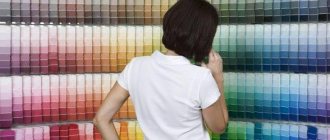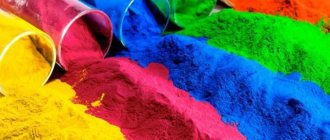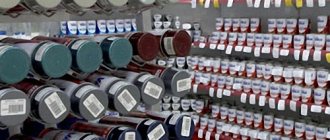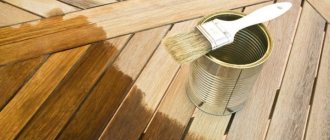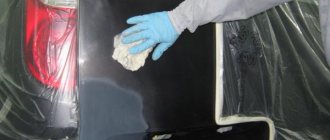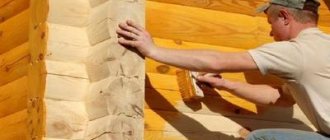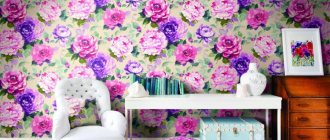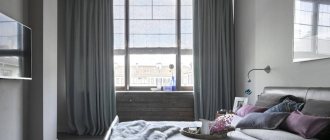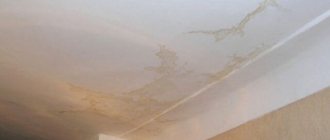What determines paint consumption?
The most popular coloring composition is water-based.
It is affordable and has excellent technical characteristics; easy to use, and also harmless to human health and the environment. The scope of application of this composition is quite wide. After all, they can be used to paint surfaces made of any material. Water-based emulsion is suitable for painting walls both indoors and outdoors.
What will be the consumption of water-based paint per 1 m2 depends on many factors:
- The tool with which the coloring composition will be applied;
- Material of the surface to be painted;
- Surface condition and texture;
- Air temperature in the room where the work will be carried out;
- Type of material by component composition. So, acrylic composition has the lowest consumption, silicone takes second place, followed by silicate, polyvinyl acetate and latex.
Dependence of consumption on the selected tool
How much coloring material will be used for painting directly depends on the tool with which we will paint the surfaces. The best option for applying it is to use a roller. They come in different types: for a smooth surface it is better to take a short-haired roller, and for embossed walls or textured finishes - a long-haired one. The longer the fibers of the tool, the more composition it will take.
Important: The most unsuitable option for water-based emulsion is a paint brush. It will waste a lot of paint. The best option to save material is to use a spray gun. With its help, we can regulate the pressure and flow of the water emulsion.
We paint different surfaces
The consumption of water-based paint per 1 m2 of wall largely depends on the material of the surface that we will paint. So, when applying the composition to wallpaper, there will be a large consumption, since the paper absorbs the water-based emulsion well.
For painting on plaster, material costs will be different. It all depends on the texture of the surface. If the coating is smooth and even, then less coloring agent will be used. But for processing, for example, fur coat or bark beetle, which have a very porous surface, more material will be consumed. But waterproof coatings will absorb less.
Advice: A surface made of polystyrene foam or wood, gypsum boards will absorb more of the paint composition due to their loose structure, but for painting metal or concrete with a denser surface, the costs will be lower.
To paint a facade, the cost of painting material will be much higher than when working indoors. Due to the air, wind and humidity outside, the paint dries quickly, so uneven coverage is possible. And this requires an additional layer to be applied to the facade walls.
Features of tinting different paints and varnishes
There are universal colors that can be added to almost any paintwork material. They are suitable for tinting materials for working on interiors and facades.
Tinting pigments with different paints should take into account the following recommendations:
To paint facades, colors that are resistant to weather conditions and the sun are used. When tinting water-based paint, the mass of pigment for the entire working composition should not exceed 20 percent. Pigments for working with water-based paints can be used for tinting adhesive, latex and dispersion compositions. The amount of dye when tinting acrylic paints should exceed 9 percent of the total volume of the composition.
The compatibility of paints and pigments largely depends on the manufacturer and composition of the substance.
Material cost calculator
Thus, GOST indicates that the nominal consumption of water-based emulsion is 100-150 ml for one layer. But this figure may vary depending on the type of surface and type of composition.
If the paint needs to be tinted, then you need to purchase the desired dye by choosing from the color palette. In order not to overpay in the store, you can calculate the material costs yourself. The color consumption per 1 kg of water-based paint is 30 ml per 1 liter of paint.
The consumption rate of water-based paint per 1 m2 is in the table:
| Type of paint | Paint consumption per 1m2 in one layer, kg | Paint consumption per 1m2 in two layers, kg |
| Latex | 0,6 | 0,4 |
| Polyvinyl acetate | 0,55 | 0,35 |
| Tex water soluble | 0,6 | 0,4 |
| Veak-1180 | 0,150 | 0,12 |
| Glass wallpaper | 0,05 | 0,03 |
Water emulsion cost calculator for interior work:
The material cost figure is always indicated on the packaging. But as confirmed by the pros, they do not always correspond to the costs in practice. Therefore, this point should also be taken into account.
Examples of paint calculations per 1 square meter of surface
The calculation consists of 3 stages: measuring the dimensions of the surfaces to be painted, calculating the area, determining the consumption based on the paint coverage indicators from the manufacturer, adjusted for working conditions. For clarity, example No. 1 is provided. The walls of a 5x6 m room with a ceiling height of 250 cm will need to be painted.
Calculation algorithm:
- The surface area minus window and door openings will be: S=S1−S2−S3. Total S1=(5+6)*2.5=55. Two windows S2=2*1.5*1.2=3.6. Doors S3=2*2*0.7=2.8. Result: S=55−3.6−2.8=48.6 m².
- The hiding power of the paint according to the information on the packaging is 16 m²/l.
- The requirement for color according to the standard is 48.6/16 = 3.1 l.
- Adjustment for tool: when working with a roller, the flow rate increases by 10%. You need to purchase 3.1*1.1=3.4 liters or 3.4*1.5=5.1 kg.
Example No. 2 differs in the use of the norm in kilograms per unit area. If the packaging indicates 0.15 g/m², the basic requirement for the previously calculated area will be 48.6 * 0.15 = 7.3 kg. With the adjustment for the spray gun, 5% is added, total: 7.7 kg.
How to save coloring agent?
To save coloring material, you must follow some rules when applying paint. Before you start painting, the walls must be coated with a primer or other compositions of a similar effect. The primer will create a coating on the surface that will reduce material consumption and at the same time help improve adhesion between them.
Another trick to save material is to add more water or PVA glue to the mixture. Thus, the volume of the composition will increase and it will be enough to cover a larger surface area. Usually, when painting, two layers of paint are enough. At the same time, they should be thin, with the second layer being smaller than the previous one.
We study and use the tinting table: color for water-based paint for walls
The tone of the painting material offered by the manufacturer does not always satisfy the consumer.
To give the desired shade to the composition, water-based paint color is added to its base.
… VKontakte Facebook Twitter Google+ My world Contents:
- What are colors
- Types of colors, how to choose, how to dilute and how to choose a color
- Sequence of tinting
- Features of the use of colors
- Useful video: mixing color with paint
Tips for choosing color mixtures
When choosing a suitable color concentrate, you need to consider what composition of the water-emulsion suspension will be tinted. The composition of dyes can be:
- adhesive;
- latex based;
- water-dispersed.
You can choose a tinting tone for them, taking into account the constituent base, or choose a universal one, suitable for all types of water-based acrylic paints.
In addition to the main component, when purchasing you need to consider:
- How much tinting concentrate is needed for 1 kg of dye, and purchase it immediately in the required quantity. It may happen that then the desired color is not available for sale and you will have to either postpone the repair for an indefinite period of time, or do tinting, selecting the tone by mixing different color combinations, as suggested by the artistic mixing table.
- That the color for water-based paint produced by different manufacturers may vary in shade. You need to purchase the same brand of tinting product.
- Before purchasing, it is advisable to study the catalog from the manufacturer, which clearly indicates the color that matches the shade of the concentrate being purchased. In addition, the catalog must indicate the required amount of color per 1 kg of material to obtain the desired tone.
- In cases where there is a need to create a complex color tone, it is recommended to use a table from the manufacturers of tinting mixtures of this brand. It is with the help of such tables that you can determine the required color combination per 1 kg of material.
- It is better to purchase bottles with a narrow neck from containers - this shape of the container allows you to conveniently dispense the coloring composition.
The coloring base should have a pure white color without yellowish impurities inherent in most white dyes. Yellowish pigments during tinting will prevent you from obtaining the desired shade. For example, if there is a small amount of yellow pigment in the source material, adding red can produce a reddish-orange hue rather than the desired red.
What are colors
A color is a concentrated pigment based on a binder or a paste-like consistency saturated with one of the colors. The main purpose is to give existing paints the desired shades.
Coloring pastes are used for all surfaces. Before painting them, each owner is puzzled by choosing the right color so that the latter simultaneously matches the interior. Retail tones do not always meet consumer needs, and choosing the right one can be difficult.
Why do you need a paint color? White color is usually taken as a basis, and in order for it to acquire the intended shade, concentrated pigment is added to it. Mixing the color with the coloring base is carried out in the following quantities:
- no more than 20% for water-based paints;
- no more than 1.5% for oil-based paints;
- no more than 7% for other types of paints.
Such decisions were made due to the high saturation of color schemes. With a high concentration of color, the performance of the paint is reduced.
Tips for choosing color mixtures
When choosing a suitable color concentrate, you need to consider what composition of the water-emulsion suspension will be tinted. The composition of dyes can be:
- adhesive,
- latex based,
- water-dispersed.
You can choose a tinting tone for them, taking into account the constituent base, or choose a universal one, suitable for all types of water-based acrylic paints.
In addition to the main component, when purchasing you need to consider:
- How much tinting concentrate is needed for 1 kg of dye, and purchase it immediately in the required quantity. It may happen that then the desired color is not available for sale and you will have to either postpone the repair for an indefinite period of time, or do tinting, selecting the tone by mixing different color combinations, as suggested by the artistic mixing table.
- That the color for water-based paint produced by different manufacturers may vary in shade. You need to purchase the same brand of tinting product.
- Before purchasing, it is advisable to study the catalog from the manufacturer, which clearly indicates the color that matches the shade of the concentrate being purchased. In addition, the catalog must indicate the required amount of color per 1 kg of material to obtain the desired tone.
- In cases where there is a need to create a complex color tone, it is recommended to use a table from the manufacturers of tinting mixtures of this brand. It is with the help of such tables that you can determine the required color combination per 1 kg of material.
- It is better to purchase bottles with a narrow neck from containers - this shape of the container allows you to conveniently dispense the coloring composition.
The coloring base should have a pure white color without yellowish impurities inherent in most white dyes. Yellowish pigments during tinting will prevent you from obtaining the desired shade. For example, if there is a small amount of yellow pigment in the source material, adding red can produce a reddish-orange hue rather than the desired red.
Types of colors, how to choose, how to dilute and how to choose a color
Color is added to the paint to give it a color that matches the style of the room.
Types of pastes are divided into:
- inorganic;
- organic.
The second ones on the list have bright tones. At the same time, the choice of color palette is quite large. But, despite this advantage, there is one drawback - they quickly fade when exposed to sunlight.
Inorganic pigments are produced in limited quantities; their colors are dull, but they retain their color properties for a long time.
How to choose a color for painting walls? To do this you need to do the following:
- Explore the proposed catalog.
- In the absence of a color code, it is not necessary to experiment with obtaining a tone in a store, since the color obtained in this way will differ from the one created in everyday conditions.
- The color must be mixed with a small portion of the color base.
- When lighting a room artificially, it is recommended to use organic pigments, and when natural color predominates, inorganic ones.
- The products of a foreign manufacturer are not necessarily better than domestic ones. Russian manufacturers produce tinting pastes of no less quality than the products of their foreign colleagues.
- You should pay attention to the neck of the bottle, it should be narrow, this will make dosing easier.
- A palette of water-based paints will not be superfluous when purchasing diluted pigment, it will be easier to navigate in order to get the expected shade.
What are the different paint colors from modern manufacturers? Well-known brands of tinting pastes include:
- Tikkririla. The products of this company are designed to obtain the expected result after initial dilution with the base. In total there are more than 2000 tones from this manufacturer. The manufacturer offers a choice of a number of shades for painting facades.
- Natural Color System (NCS) - the color is made according to the standards of Swedish and Norwegian manufacturers. There are only 6 primary colors in the range: yellow, black, red, green, blue and white. Other tones are derivatives of them. Based on the letters and numbers printed on the containers, it is easy to decide on the choice of color.
- Tex is a company that produces pastes based on pigments produced outside the Russian Federation. They are versatile and are used to add color to water-based paints, putties and added to whitewash. Used for interior work and painting facades.
- Rogneda is a network of Moscow organizations that produces products for artistic purposes and adding tone to paint, plaster or putty. The color of this company is resistant to exposure to the sun and negative temperatures, and also has high adhesion properties.
- Elakr is a color for façade paint. It is resistant to negative environmental factors and resistant to light. Ideally stored at sub-zero temperatures. Most façade paints are produced on a white base and require diluting to give them color.
Is the color white or not? Basically, the manufacturer produces colored pastes in light and rich colors, but in some cases there is also a white color. It is typically used to provide weather resistance and abrasion protection for advertising lettering and graphics.
Important! Products for water-based paints have gained the greatest popularity, but for other types of paint bases it is not difficult to purchase the appropriate pigment.
Tips and tricks
Both Russian and foreign manufacturers have a large selection of types and shades of colors. Domestic paints not only have a more favorable price, but are also not particularly inferior in quality, so there is no point in chasing expensive foreign products. It is recommended to use snow-white paint as a basis for tinting, and not just white paint. The latter often has a yellowish tint, which can greatly affect the tinting result. Don’t get carried away and pour half a bottle of dye into the base at once. Even a few drops of colorant can already noticeably change the color of the paint. Colorants can be used not only to obtain the desired shade of paint, but also added, for example, to plaster.
Note! Many people mistakenly call tinting any mixing of paints of different colors.
However, there are two concepts for this action:
glazing - if two different colors are mixed to obtain a third (for example, yellow and blue to create green); tinting - adding a dye to white paint.
Sequence of tinting
How to tint paint at home so that the color matches what you expect? First you need to calculate the amount of material needed to perform painting work in a given room.
If there is not enough paint to complete the work, it is unlikely that the same proportion will be maintained again. How to dilute color in water-based paint?
Stages of obtaining color:
- Pour a small amount of white paint into a small container.
- Then the color is added to the white base little by little, and it is important to record how much coloring matter was added. In this way, the expected shade is achieved. The main thing is to remember how much color was used.
- It is recommended to add the coloring mixture in drops using a syringe with the needle removed. This will make it easier to follow the dosage.
- After obtaining the desired tone, the surface is painted. This is necessary to ensure that the color meets the requirements. Moreover, it is enough to paint an area of no more than 0.5 m2.
- If everything is fine, then you can thin the paint and safely paint the walls. If an unsatisfactory result is obtained, experiment any number of times.
To get a rich color, the color should be added to the paint before painting operations, but no later than 2 hours before starting work. If the time period is increased, the pigments will settle to the bottom and the painted surface will not be as bright as expected.
Important! Wall surface colors are checked for consistency using lighting fixtures. Surface mixing of the color is not suitable; it should be mixed thoroughly, preferably with a mixer. The preparation of the paint composition should be done in one container.
DIY tinting
If tinting paint is done manually, then it is better to do it in the room in which it will be used. This will help you achieve the perfect color for the lighting conditions of a given room.
When tinting paint with your own hands, you should remember that no matter how hard you try to remember the proportions, you will not be able to perfectly repeat the same color a second time; the differences will be noticeable to the naked eye. Therefore, the paint must be diluted in a large container so that there is enough for the entire room at once. It is better to add a 5-10% reserve to the paint consumption per 1 square meter indicated on the packaging.
Advice! You can make the process of selecting the right shade easier by downloading a paint tinting program.
It is advisable that the white paint and color be produced by the same company. Manufacturers may have significant differences in paint production technology and its composition, so it is better not to take risks, otherwise you may end up with a coating not only of a strange color, but also with poor performance characteristics.
Important! You should only use paint specifically designed for the surface. Products for ceilings, walls and floors have completely different indicators of soiling, wear resistance, etc.
As a rule, a paint tinting table is included with the color scheme, demonstrating the possible proportions of mixing colors.
Large manufacturers, for example, Tikkurila, offer customers entire catalogs of paint tinting, available in paper and electronic form.
To stir the paint, you must use a mixing attachment on a drill or hammer drill, since long and thorough mixing of the mixture by hand will still not give a uniform result. The paint is mixed until a mass of uniform color and density is obtained.
The color of the paint in the container may differ slightly from what you get when applying it to the surface. To see how this shade will look on the wall, you should prepare a test mixture (trying to remember the exact ratio of the components), and then paint a small area and wait until it dries at least a little. Although even if the proportions are observed the second time, it will not be possible to obtain absolutely identical colors, a test coloring will still help to get a rough idea of the result. It should be remembered that as it dries, the color of the walls will become somewhat less bright and saturated.
If you don’t like the resulting color, you can change it by adding either a little more color or, conversely, white paint. If water-based dyes were used, the mixture can be diluted with water.
Advice! If the color is in an inconvenient package, from which it is difficult to add it to the paint in small quantities, then it will be convenient to use a regular syringe.
Features of the use of colors
Kohler means tone or color (this is a translation from Latin). Depending on the dosage of the added material, the desired shade can be achieved. It is used for painting interior and exterior substrates.
Designed for painting:
- wood surfaces;
- concrete;
- bricks;
- plasters;
- drywall;
- metal
Suitable for paints based on water-based compositions, oil-based and alkyd, epoxy compositions, nitrocellulose and polyurethane foam.
The color chart is specially designed to facilitate the selection of colors. It indicates the proportions of paint and color.
For example, 1:5 means that the color consumption for five parts of the main color is one part. There is no need to add a large amount of material at the same time, since the paint base can be ruined.
To properly perform dilution, you must adhere to the requirements set out in the instructions developed by the manufacturer. The measurements must be the same volume. It is important to know that it is better to purchase paint and color from the same manufacturer.
Is it possible to paint with color? This is a question some people ask. The color is specially designed to impart tonality to the main color; it is rich in pigment. Therefore, its basis is a binder. The adhesion between the surface and the base will be the same as when painting with regular paint. So the color itself can be used for painting work, but it will be quite expensive.
Advice! If the concentrated pigment is not used in full, then the remaining material can be mixed with water. Thus, it will be preserved for at least 5 years.
Formula for calculating the required amount of materials
Using the records of the amount of water-based paint and color in the test batch, calculate how many drops of color will be needed to dilute the entire volume of water-based paint.
For example, if for painting the walls in a room the required volume of paint was determined to be 10 liters, in the process of preparing a test volume it turned out that to paint 100 ml of paint in the desired tone you will need 10 drops of paint, then the calculation looks like this:
- 10 drops 10 10 l = 1000 drops
- 1000 drops - 20% = 800 drops
This method is suitable for both simple and unusual and original color combinations.
By following the recommendations of experts, you can independently prepare a composition to implement any design ideas.
Color Mixing Chart
- Articles, repairs, instructions
The choice of paint today is good, but if you need a rare shade that is not on sale, you will have to mix several tones. We offer a color mixing table, which indicates which tones and in what proportion should be mixed to obtain the original shade.
Some tips:
- — The color of the paint manufacturer does not always correspond to the classic one, so the proportions may vary slightly,
- — Keep in mind that acrylic paint darkens when drying, as water evaporates and increases the concentration of pigment,
- — Do not spread all the paint at once - do a test spread,
- — The best mixing option is to use a mixer (attachment to a drill).
| Visual display | Color name | Mix to get it |
| Pink | 90% white + 10% red | |
| Royal red | 5-10% blue is added to red | |
| Tomato red | Add 5% brown and yellow to red | |
| Crimson | Blue base + a little white, brown and red in equal proportions | |
| Chestnut | Add 5% brown and 3% black to red | |
| Red | If you want to lighten red, add white | |
| Orange | Add up to 30% red to yellow | |
| Yellow | Yellow - lighten with white, darken with red and brown | |
| Olive | Green base + 10-20% yellow | |
| Turquoise green | Add up to 25% blue to green | |
| Bottle green | Yellow + 20-40% blue | |
| Turquoise blue | In blue 10-15% green | |
| Royal blue | In blue 10-15% black and 2% green | |
| Dark blue | Blue + 5% black and 2% green | |
| Grey | In white to 5% black | |
| Medium brown | Add red and blue to yellow in equal portions, add white if you want to lighten it, darken it with black. | |
| Golden brown | To yellow we add 10% blue, white and red, the more yellow, the higher the contrast. | |
| Mustard | In yellow, 5% black and red + 1-2% green | |
| Beige | Add white to brown while stirring until the desired tone is obtained, add yellow for brightness | |
| Pink gray | In white up to 5% black or red | |
| Gray-blue | In white up to 5% light gray + 1% blue | |
| Green-gray | In white 5% light gray + 1% green | |
| Gray coal | Black is added to white until the desired tone is achieved (with constant stirring) | |
| Lemon yellow | In yellow 5% white and 1-2% green | |
| Fern green color | Add black, green and white paint in equal parts to white | |
| Forest green color | Green is diluted with black (up to 5%) | |
| Emerald green | Yellow diluted with white (less) and green (more) paint | |
| Light green | Yellow is diluted with white (5%) and green (10%) paint | |
| Aquamarine | Add up to 35% green and 5% black to white paint | |
| Avocado | Add black and brown paint to yellow in equal parts (up to 10%) | |
| Royal purple | Red color is diluted with yellow and blue paint | |
| Dark purple | We dilute the red tone with black and blue paint | |
| Mandarin, orange | In yellow paint up to 10% red and up to 5% brown | |
| Reddish chestnut | Red is diluted with black and brown | |
| Orange | White diluted with red and brown | |
| Burgundy red color | Add 5-10% yellow, brown and black paint to red paint in equal parts | |
| Plum | In red, 10% black and blue and 5% white | |
| Chestnut | Add white, red and black paint to yellow in equal proportions | |
| Dark brown | In yellow paint 10-20% each of red, white and black | |
| Black | Black is lightened to different shades of gray with white |
What is paint color?
The word “kohler” is translated from the Latin “color” as color or tone. In the chemical industry, color is a special highly concentrated pigment composition with which you can obtain almost any shade of paint. Moreover, not only water-based products, but also façade, oil, and acrylic products can act as a base. Depending on the concentration of such pigment composition in the paint, you can achieve both rich and bright colors and muted, pastel shades.
What is it needed for
The use of color helps property owners turn almost any design idea into reality. The process of mixing and diluting paint and varnish material with pigment is called tinting. Its use is suitable not only for finishing work inside the building, but also outside it. Using a special pigment solution, you can obtain unique shades, for example, the paint can be given a copper, pearlescent, bronze, or golden hue.
The color can be used on concrete, brick, plastered walls. Other surfaces can also be treated with compositions using it: plasterboard, wood, fiberboard, chipboard. The use of tinting is necessary in the following cases:
- the original layer has minor defects;
- you need to choose a shade in accordance with the color scheme of the interior;
- you need to decorate the interior using several shades of one or more colors;
- you need to correct errors that occurred when calculating the volume of paint or the absence of a color used previously.
Kinds
When planning to buy a color for water-based, acrylic or any other paint, familiarize yourself with the types of these products. You can order it in a specialized online store with delivery by mail. According to the range of applications, it can be universal, i.e. compatible with any paint and varnish materials, and highly specialized. Colorants are produced in the form of paint, dry composition, paste. The latter option is more convenient to use, but there is a possibility that the intensity of the finished paint will be uneven. Based on their composition, the following colors are distinguished:
- With organic pigments. Products of this type are distinguished by a more saturated range of colors, but the paints and varnishes obtained from them lose their brightness and saturation over time due to exposure to sunlight. For this reason, compositions with pigments of organic origin are considered not the best choice for facade paints.
- With inorganic pigments. Such products are more resistant to aggressive external factors, including burnout. True, this paint color cannot boast a wide range of shades.
Rules for tinting
You can tint the paint manually or computer-aided. Thanks to the first option, you can save a significant amount of money and perform the procedure directly at the repair site. There is also a drawback: it is almost impossible to reproduce exactly the same tone again. The second type of tinting is controlled through a special program. The operator only needs to select the color scheme, and the program itself will determine the proportions, after which it will produce the finished composition.
When deciding to dilute the pigment yourself, consider the technique:
- Decide on the required amount of color. It is better to initially buy more than to look for identical products later.
- It is recommended to select a color for painting surfaces by making a sample. To do this, fill a small container with 100 mg of white paint and add a few drops of pigment to it. By mixing, obtain the desired shade.
- Check how the resulting composition looks on the wall or other surface that needs to be painted. The color of the finished solution does not always match the shade of the paint and varnish material applied to the wall. The result should be viewed under the lighting prevailing in the room (artificial or natural), after the composition has dried.
- If you know how many drops you had to add to get the desired color, then by recalculating the consumption of the composition per liter of paint, you can dilute and get the required amount of color.
- The pigment composition should be added to the paint and varnish material in a thin stream. At the same time, do not forget to mix everything thoroughly to obtain a concentrated composition with a uniform color.
Computer operation
There is color selection using a special computer program. In this case, you can use tinting machines (varnishes and enamels are most often used) or a special catalog from the manufacturer of the pigment liquid.
Computer color tinting has become widespread due to a number of advantages:
obtaining the desired color in the shortest possible period of time; the desired shades can be re-created if you save the desired tone in the computer; There is a huge palette of colors and shades.
The main disadvantage of carrying out such work is the impossibility of creating the desired color at the work site.
What to consider
Painting a wall using a color scheme uses a special device that can be purchased at a special hardware store. Tinting with acrylic paint must comply with certain requirements:
Color paint is created directly inside the room that will be painted. This is necessary to evaluate the resulting tone in both artificial and daylight; color shades for water-based paint should be added in small parts or drops so that the dye does not damage the main tones; You should also take into account that the paint on a large area looks a little different than on a small section of the wall.
It is quite difficult to obtain a black color, since even one drop of it can completely change the color, and it will be much more difficult to lighten it. Very often the result is a dull gray color. That is why you should stock up on small jars and do everything carefully and consistently, using the product drop by drop. It is also important to remember that on a wall using water-based paints, the resulting color will look much brighter than in a container.
We recommend: How to remove wallpaper from walls - quickly and easily
To obtain a good result for mixing, you should choose white paint of the desired base and without any yellowish admixture. Color for acrylic paint will give the desired color only when using a snow-white base. If you plan to paint the walls, then the colors should be chosen specifically for them, and not for the ceiling, which plays an important role. These types of compositions for acrylic paints have some differences in terms of wear resistance, elasticity and soiling.
If you need to re-tint water-based paint, it is very important to purchase the compositions from the same manufacturer, since one tone can vary greatly between different brands.
When purchasing latex paint, you need to remember that it has a rather thick consistency, so it requires high-quality and long-term mixing. The solvent in this case will be water, which is carefully poured in until the desired mixture is formed. After adding water, the main dyes are carefully added dropwise to the composition.
How to choose a paint color
To begin with, depending on your goals, choose between organic and inorganic products, taking into account the features of each option. Then decide on the state of the color: liquid composition, paste or loose pigment:
- The first option contains the same components as in the paint and varnish material (paint and varnish material): if you are going to use water-based paint, then the color composition should be the same.
- Bulk pigment is inexpensive, but it has a limited palette.
- The most convenient option is color paste.
Choose the right color:
- You can choose a shade using the catalog - it is available in every specialized store. Please note that the shade looks different depending on the lighting.
- If the room where you want to paint the walls is light, then give preference to a synthetic pigment. Under artificial lighting, colors that contain organic substances look great.
- The color scheme of the surface should be in harmony with the background of the flooring and furniture. If the floor is made in a green-blue shade, then it is better to decorate the walls in a golden or yellowish tone. If the floor surface is brown, it is better to make the wall color beige.
- The range of wall coverings can be rich and bright: it is known that rich shades can lift the mood. These include lush green, golden, brown or ocher tones. Please note that blue shades in evening light appear more faded than in daylight.
- Please note the manufacturer. Well-known suppliers of colors are Caparol, Monicolor Nova, Colorex, Izhsintez, Decorazza, Unisistem, Olki, etc.
For water-based paint
If you are looking for a high-quality color for water-based paint, then pay attention to the universal dye “Profilux PROFICOLOR No. 18 blue. Can be used for cement plasters, oil-based paints and varnishes. At the same time, it is cheaper than many other pigment compositions - only 30 rubles apiece. The composition is environmentally friendly, water based:
- name: Profilux PROFICOLOR;
- price: 30 rub.;
- characteristics: country of origin – Russia, volume – 0.13 l, colors – blue, caramel, brown, black, coffee, etc.;
- pros: reasonable price, low consumption, large selection of colors;
- cons: none.
Another excellent universal dye option is Dufa D 230. This high-quality diversified dye is made on the basis of synthetic resins. Intended for decorative design of interior and façade surfaces. Water is used as a solvent:
- name: Dufa D 230;
- price: 365 rub.;
- characteristics: volume – 0.75 l, colors – red, wood brown, yellow, orange, green apple, etc., consumption rate – 0.15-0.20 l/m2, gloss level – deeply matte, density – 1 .3 kg/l, application temperature – from +5 degrees, shelf life – 5 years;
- pluses: large palette of colors, high quality, light fastness, resistance to abrasion, lime;
- cons: costs more than analogues.
For tinting water-dispersion paints and decorative plasters, products from Tury Scandinavia Classic are a good option. Suitable for paintwork materials that are used both inside and outside the object:
- name: Tury Scandinavia Classic;
- price: 206 rub.;
- characteristics: packaging – 1 kg, drying time – about 1 hour, colors – mint, salad, green, lemon, red-brown, pink, beige, etc.;
- pros: low cost, large range of rich and bright colors;
- cons: large packaging.
For acrylic
If you are looking for a suitable color for acrylic paint, then PalIzh products may suit you. This pigment composition is recommended to be used not only for tinting acrylic paints and varnishes without limiting the percentage of input, but also for painting and painting small surfaces: concrete, wood, brick, stucco, canvas, etc. More details about the product:
- name: PalIzh;
- price: 211 rub.;
- characteristics: weight – 0.25 kg, drying time – 1 hour, consumption per 1 layer – 150 g/m2, colors – pink, blue, metallic purple, metallic emerald, etc., shelf life – 5 years;
- pros: quality, original colors;
- cons: high cost.
Another good choice would be the universal PalIzh Standard product, used for tinting paintwork materials, wood glazes, plasters and grouts on organic and water-dispersion bases. The product is compatible with paints from any manufacturer. It retains its consistency and properties during several freezing cycles:
- name: PalIzh Standard;
- price: 52 rub.;
- characteristics: volume – 0.1 l, shelf life – 5 years, colors – graphite, gold and silver veneer, sunny, fuchsia, coral, scarlet, dark red, etc.;
- pros: high versatility, saturation, brightness;
- cons: costs more than analogues.
For facade paint
Products from the Faydal brand are perfect for tinting façade paintwork materials. Its pigments are highly resistant to UV radiation, and the color itself is available in 19 bright and rich shades. This product is also suitable for tinting interior paints, putties and water-based plaster mixtures. It can be used for application indoors on mineral surfaces such as brick, concrete, drywall, glass wallpaper, and any type of putty:
- title: FEIDAL VOLLTON – und Abtönfarbe;
- price: 468 RUR;
- characteristics: volume – 0.75 l, specific gravity – 1.4 kg/l, gloss – deeply matte, composition – acrylic dispersion, fillers, pigments, functional additives, water, colors – chocolate, umber, apricot, etc.;
- pluses: resistance to ultraviolet radiation, high covering power, original shades;
- cons: bulk packaging.
Another good color for facade paint is JOBI. The product is suitable for the decorative design of facade and interior elements, tinting water-based paints and varnishes, plasters and enamels. Can be used in its pure form for stenciling and artistic work:
- name: JOBI;
- price: 182 rub.;
- characteristics: volume – 0.5 l, weight – 0.7 kg, colors – apricot, anthracinte, burgundy, yellow, green, etc.
- advantages: light and weather resistance, high air and vapor permeability, reasonable cost;
- cons: none.
For oil paint
Aqua-Color Unicolor is a universal acrylic tinting paste, ideal for finishing the facades of buildings and country houses. This color is available in a wide range of colors and has excellent compatibility with alkyd-oil and water-based materials. They can even tint grout and cement mortars. It is used for repairing offices, apartments, building facades, and cottages. Ideal for oil paints:
- name: Aqua-Color Unicolor;
- price: 50 rub.;
- characteristics: volume – 100 ml, consumption – 100 ml/20 kg paintwork materials, colors – lemon, yellow, light ocher, dark, red-orange, etc.;
- advantages: light fastness, low consumption, convenient packaging;
- cons: none.
If you are looking for a relatively inexpensive color for oil paint, then pay attention to the universal products from Krafor. The use of this paste is possible even for non-traditional materials, but a preliminary test must be done. Suitable for external and internal work:
- name: Krafor;
- price: 31 rub.;
- characteristics: volume – 100 ml, shelf life – 36 months, composition – pigment, polyhydric alcohol, special additives;
- advantages: high coloring power, light fastness, wide color gamut;
- cons: minimum quantity of 6 pieces.
Do-it-yourself paint tinting - detailed instructions
Paint and varnish products are presented on our market in a huge number of colors. However, sometimes it is not possible to find the right shade. But today this is not a problem, since modern colors allow you to achieve any color you need. But such means must be used as carefully as possible, since it is easy to overdo it.
Advantages of tinting over buying ready-made paint
The ability to create colors that simply aren't available in the stores you visit. In fact, the range of many of them is very limited and is represented by paints of the most popular colors. If you want to go beyond the standard, then tinting is often the only option; The paint has bulged and needs to be replaced, or there simply wasn’t enough to complete the finish. You need additional paint, but the city stores don’t have it, and there’s no time for a more detailed search. The situation is very common, and here precise selection of colors can solve the problem; Tinting is used if you need to choose shades that are in harmony with each other as part of the decoration of the room.
What paint is suitable for tinting
As a rule, white paint is selected for this process, to which a certain amount of color is added. However, not every paint is suitable for this. The reason is the proportion of pigment and binder. If there is a lot of pigment in the paint, then adding additional pigment in the form of color can lead to the fact that there simply is not enough binder.
Advantages and disadvantages of computer tinting
Now there are special machines that allow tinting work to be carried out automatically. The use of these devices has the following advantages:
Getting rid of the human factor. If by manually selecting the tone you can make a mistake and go too far, which happens quite often, then the robot does not allow such mistakes; Selected color parameters can be reused - the final product will be exactly the same; A large number of flowers; The disadvantage is that it is tied to a specific location and the inability to carry out work directly on site. Moreover, not everyone lives in big cities where such devices are available.
Advantages and disadvantages of manual tinting at home
Tinting machines can create a variety of colors, but complex and individual shades are difficult to achieve. Man will always be limited by standards; Possibility to carry out paint creation work on site. During a designer renovation this can be very important; Saving time and money. The color itself is very inexpensive, and white paint also does not belong to the category of expensive materials. The disadvantage is the high probability of making mistakes in the absence of experience. Additionally, getting the color back can also be a challenge. Sometimes, having re-applied the resulting color next to a previously painted surface, we immediately notice a difference, and a very significant one.
Manual tinting - counting ingredients
In order not to mess up the color, you will need a pen and a piece of paper, as well as all the reserve of attentiveness that you have. You also need to provide yourself with variability, so prepare several pieces of dishes, the same in volume and always clean. The ideal solution is yogurt jars.
We recommend: What is apartment finishing?
It is necessary to record how much paint you pour into the jars and how much color you use to change the color. It is necessary to understand that the color itself is an extremely saturated pigment concentrate, so it must be added carefully. It is best to start with two drops, after which, if you are dissatisfied with the result, add drop by drop. It is necessary to mix everything very well so that the pigment dissolves thoroughly.
When applying paint to a wall or other surface in test mode, you need to understand that after drying the color will appear more strongly. So before painting, you can create a paler shade than the one you want to achieve. Having assessed the result after drying and thus obtained a recipe, you can use it to tint the rest of the paint.
But here you need to understand that with a large amount of paint, the volume must be reduced by 20 percent, since a large painted surface always looks brighter than a small one. Therefore, if in your recipe it turns out that you need to add 100 drops of color per liter, it is better to get by with 80 drops.
Two types of colors
All colors are divided into two types, which we will describe below:
Organic. Typically, the shades obtained using these pigments are brighter and richer. However, these tinting systems have disadvantages. So, they are not suitable for all types of surface. In addition, the paint modified with their help fades over time in the sun. Inorganic. Much more resistant to solar radiation and atmospheric influences, but at the same time much less varied in the choice of colors.
Forms of color release
Today there are several forms of tinting systems on the market, which have their own advantages and disadvantages: Tinted paints. In terms of their chemical composition, they are completely identical to the paints to which they are added. By gradually adding colorant to white paint, you can get almost any shade. If you want to get the brightest color possible, then you can use the colorant itself as a coating material. True, this will not be very economical, so it is better to paint limited surface areas in this way; Color pastes. They are a pigment diluted in a dispersing resin, or without a binder component. The advantages of this paste include its ease of use, but the disadvantage is the lack of uniform intensity. Available for all types of paints, and in a more highly specialized form; Dry colors. They are inexpensive, but are not recommended for use with ready-made paints, and also have a rather small color palette.
Tinting and various types of paint
When tinting, it is necessary to take into account the types of paint with which the color will be mixed. Of course, there are now universal options on the market, but when working with this or that paint, you still need to follow some rules:
Acrylic paint. Here it is necessary to remember about the limitation of the maximum amount of pigments, which should not exceed 7-8 percent of the total volume of paint; Water-based paint. In its case, the maximum volume of color should not exceed a fifth of the total amount of paintwork materials. At the same time, those colors that are intended for water-based paints are suitable for water-dispersion, latex and adhesive paints; Important! If you are planning to tint facade paint, then the ideal solution would be to choose a color that is resistant to ultraviolet radiation and various natural influences. As mentioned above, inorganic colors are suitable for this, but organic colors will quickly lose their color.
Community tips for tinting
To facilitate the process of obtaining the desired color, it is best to use special tables. They show the shade and contain information about how much color is needed to obtain them. The table itself must be made by the manufacturer who made the paint. It is highly desirable that the color also be made by the same manufacturer.
It is best to use colorant that is poured into a bottle with a narrow neck. This way you can dose the ingredient as accurately as possible and are less likely to spill more than necessary.
It is necessary to mix as efficiently as possible until the shade becomes uniform. If possible, you can use a drill with different types of attachments. The work itself must be carried out outdoors or in places with natural light.
The dishes in which tinting is carried out must be the same. The reason is that the resulting color may vary between different types of material. This difference may not be so noticeable to the eye, but upon application the difference will be obvious. If we talk about artificial lighting, the most important thing here is the need to use in the process of obtaining color the lighting source that will be used in the room in the future. You should not change lighting parameters, types of lamps and chandeliers while obtaining color. This can happen during renovations, when several works are being done simultaneously in a room.
Be sure to consider the amount of pigments in the base, especially if you want to get dark tones. In different types of paints and varnishes this amount may be different.
Source: bricknews.ru
This is interesting: What to build a bathhouse from - what materials to use?
1
Colorant – which composition to choose?
Today you can easily find any dye on an organic and inorganic basis. The first option allows you to get rich shades, which, unfortunately, over time lose their properties, fade and fade. Inorganic additives are more resistant to atmospheric and other influences, but their palette is significantly narrower compared to natural materials. The product range is presented on the market with universal colorants and compositions intended for specific types of paints.
To obtain the required color, the amount of color varies depending on the type of paint and varnish material. So, for oil paints the maximum amount of colorant should not exceed 1.5–2%!o (MISSING)t of the total volume, in water-soluble paints and varnishes its amount can reach 20%!,(MISSING) and for all others a maximum of 5% is added!
It is necessary to distinguish between the concepts of tinting and glazing. In the first case, color is added to white paint to achieve the desired shade. The second term refers to mixing two different colors to obtain a third (yellow + red = orange).
The amount of tint to obtain the desired color depends on the type of paint and varnish material
Manufacturers offer colorants in powder, liquid and paste form. For independent use, liquid dyes produced in small volumes in syringes or bottles are better suited. They are simple and easy to use. With their help, you can easily change the shade of paint by adding more dye for a rich color. In addition, it is allowed to use liquid color for painting in undiluted form as a coloring material.
But for mixing on professional equipment, powders and pastes are better suited. Dry dyes are inexpensive, but with their help it is difficult to achieve the desired shade, and they have a small selection of colors. As a rule, before adding the powder, it is diluted in a liquid that corresponds to the composition of the paints (linseed oil, water). Paste-like materials require precise proportions from the master, otherwise the color may turn out to be significantly lighter or darker than the desired result.
We recommend
Bath paintPainting walls with water-based paint - choosing a material and learning to work with a rollerPaint palette for walls - learning how to combine colors correctly
Video
Popular posts
- Chair for dressing table Chairs for dressing tables in Moscow - 189 Products Company from Moscow, delivery 29643 a In…
- Silicone sanitary sealant Silicone sanitary sealant white in Moscow - 1491 products Company from Moscow, delivery (tomorrow) 140...
- Shelf in the hallway Currently, there are a huge number of different options for shelves in the hallway, and this is directly ...
- Insulation of the floor in a wooden Insulation of the floor in a wooden house from below: materials and installation technology SHARE ON SOCIAL NETWORKS One of the common…
